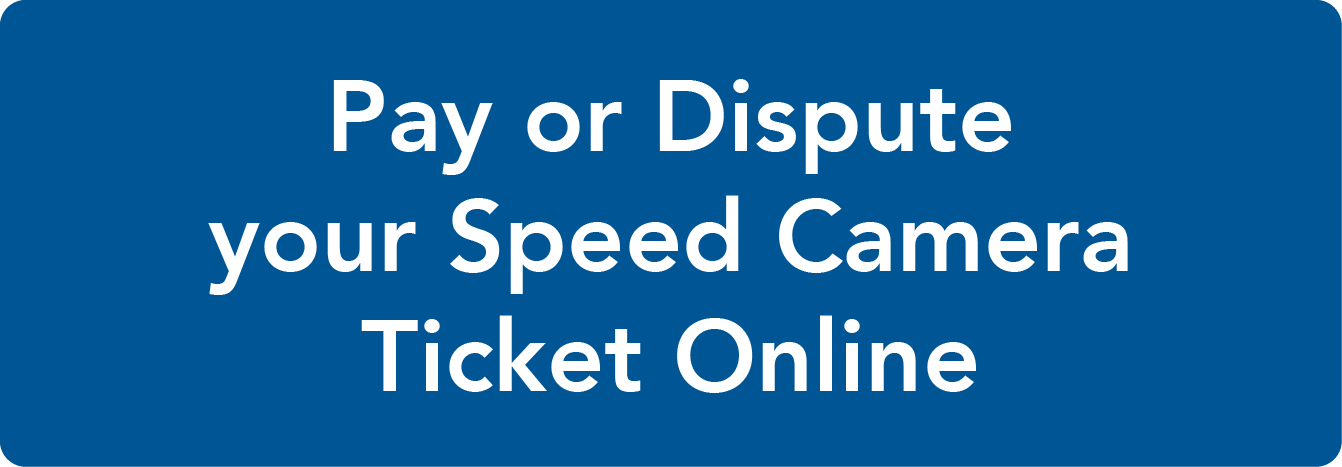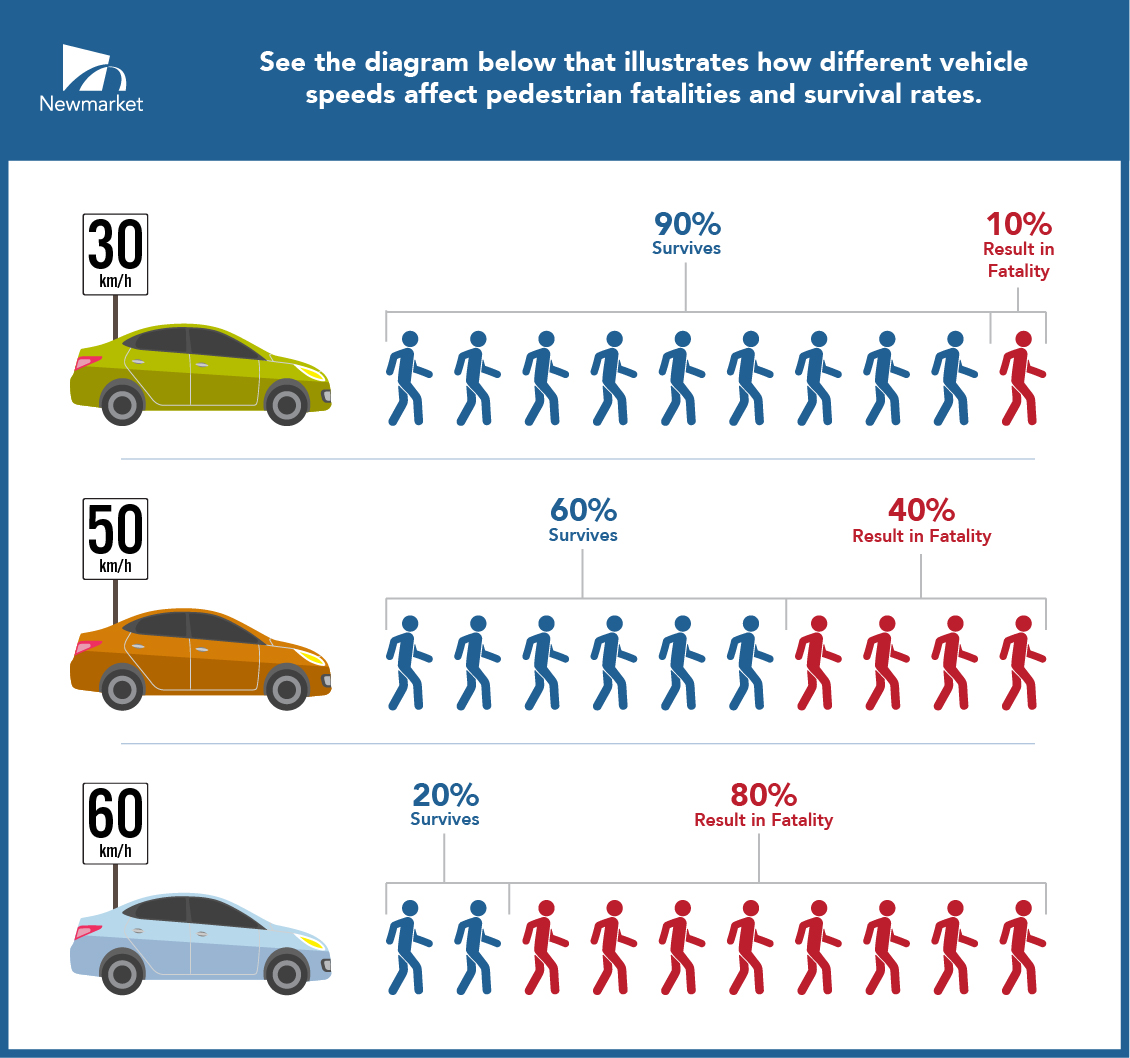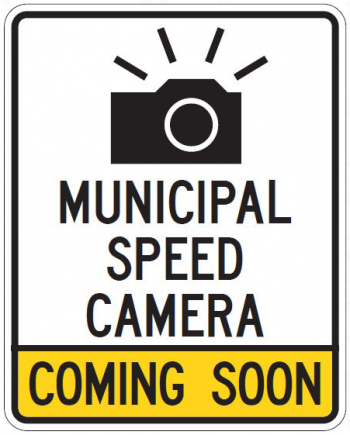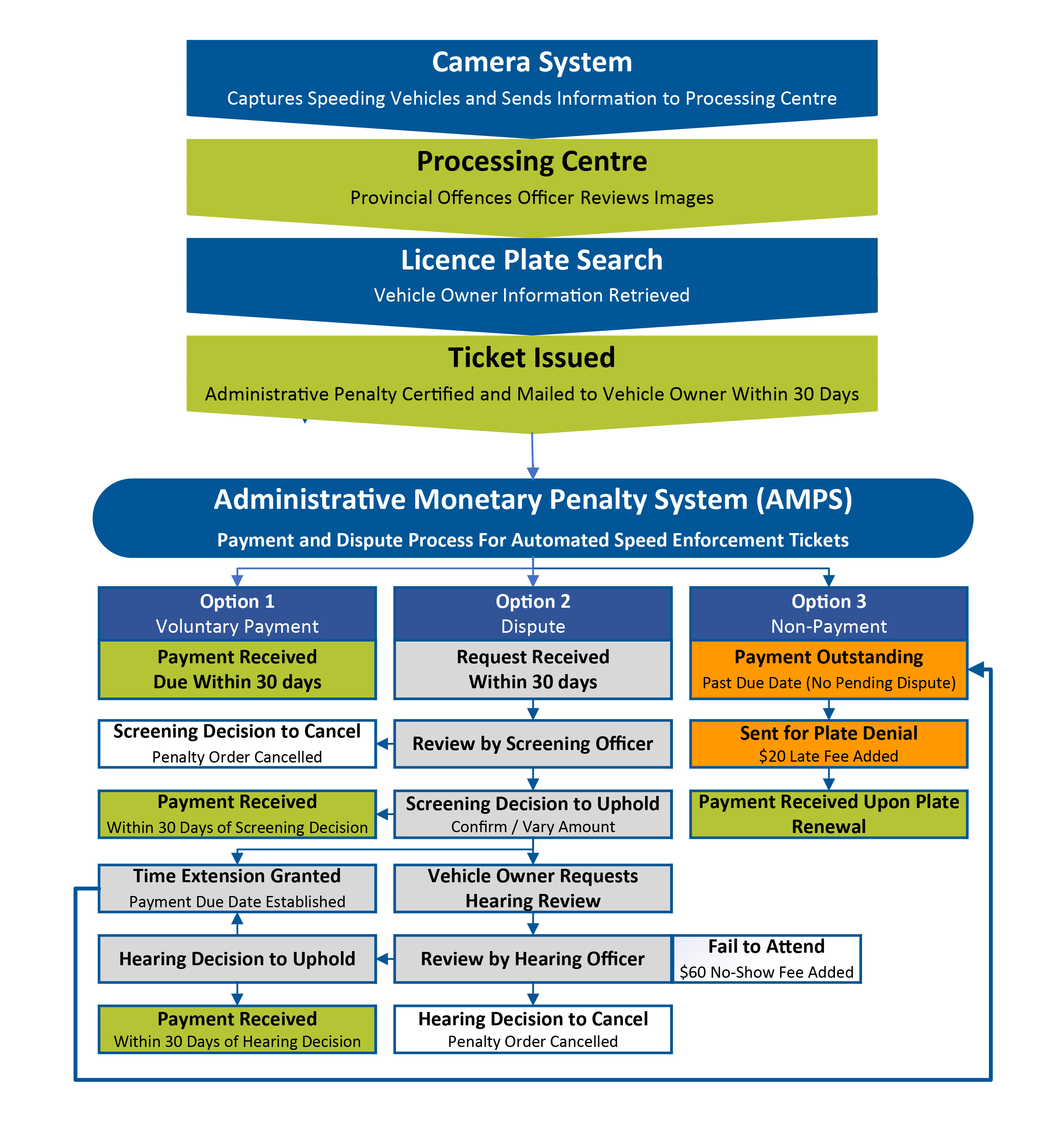
Community Safety Cameras are in effect near Newmarket School.
Newmarket's Community Safety Camera Program uses automated speed enforcement (ASE), to curb speeding, alter driver behaviour and increase safety for the community. These speed cameras will be used alongside other traffic control measures that focus on education, enforcement and engineering along with the Town’s safety mascot Safety Cone Sam. Funds collected from this program will be used to offset the cost to run the program and be used towards other safety and Town initiatives.
Pay of Dispute your Speed Camera Ticket Online

Note:
Note: This web portal will only accept payments for speed camera violation tickets. For penalties related to property standards, licensing, parking and animal control, please
visit our Bylaw Fines webpage for more information.
About the Community Safety Camera Program
See how Newmarket's Community Safety Camera works by watching this educational video below. Brought to you by Newmarket's Safety Driven Campaign, with the Town's safety mascot Safety Cone Sam, Belle the Bike and Cameron the Camera. This video is also available to view with subtitles in Chinese (Traditional), Chinese (Simplified), Russian and Farsi. Click the ⚙ button to select your desired language.
新市将在9月正式启用测速摄像头。请点击下方视频了解详细信息,并选择您需要的语言. 减速慢行。
新市將於9月正式啟用偵速攝影機。請點擊下方影片了解詳情,並選擇您需要的語言。
Город Ньюмаркет запускает свои камеры контроля скорости в сентябре. Узнайте больше, посмотрев видео ниже. Нажмите ⚙, чтобы выбрать предпочитаемый язык
شهر نیومارکت در ماه سپتامبر دوربینهای کنترل سرعت خود را راهاندازی میکند. برای کسب اطلاعات بیشتر ویدئوی زیر را تماشا کنید. روی ⚙ کلیک کرده تا زبان مورد ترجیح خود را انتخاب کنید.
What is Automated Speed Enforcement
Newmarket's Community Safety Camera program uses Automated Speed Enforcement (ASE) - an automated system that uses a camera and a speed measurement device to detect and capture images of vehicles travelling in excess of the posted speed limit. If vehicles are caught travelling over the speed limit, the speed camera will automatically capture an image of the vehicle. The images are reviewed by Provincial Offences Officers and then within 30 days, a ticket is issued to the owner of the vehicle. This means that the plate holder, as opposed to the driver, receives a ticket, which results in a monetary penalty but no demerit points.
How are Automated Speed Cameras an effective safety tool?
Several other municipalities across Ontario, North America, and the world, have relied on Automated Speed Enforcement (ASE) as a speed enforcement tool with great success. The use of ASE systems has resulted in better speed compliance, fewer collisions and less severity in the collisions that do occur.
For example, a study completed in 2022 of ASE sites within the City of Toronto showed that the proportion of people speeding in 30, 40 and 50 km/h speed limit zones dropped from approximately 60 to 43, 51 to 30 and 58 to 36 per cent respectively when the speed camera devices were operational. This represents an overall 45 per cent reduction in the proportion of people speeding in areas with an ASE device.
ASE is one of several successful road safety measures and is designed to work in tandem with other methods used to enforce speed limits including engineering activities, education initiatives, and police enforcement. For information on Newmarket's other current traffic safety initiatives please visit the Traffic Management page.

Have a question? See our frequently asked questions section by clicking the button below

Community Safety Camera Locations in Newmarket
To increase road safety for vulnerable populations, ASE systems have been placed in Community Safety Zones. Locations were selected through a data-driven approach that considers proximity to vulnerable users, vehicle speed and collision data, and where the speed limit is less than 80kmph. These locations have also been approved by Newmarket Council.
Please note that the Community Safety Camera location map is still under development and will be updated once the Community Safety Camera Program is expected to launch later this year.
Please view the map to see the location of the automated speed cameras and all Community Safety Zones.
Signage in Community Safety Zones

All speed cameras will be placed in Community Safety Zones that are typically near schools to further protect vulnerable residents and children who are travelling to and from the area. “Coming Soon” signage will be in place 90 days before the speed cameras will be activated to warn, remind, and educate the public to drive within the posted limit. Municipal Speed Cameras in use signs are placed within the Community Safety Zones to warn drivers that cameras are in use.
A Community Safety Zone is an area that has an increased risk to pedestrians. Traffic-related offences committed within the zone are subject to increased fines. Community Safety Zones are designated through a by-law by Council.
Proposed Timeline for Community Safety Camera Program
-
Week of March 25, 2024 - Installation of "Coming Soon" signs at 14 Community Safety Zones
-
June to August 2024 - Installation of speed cameras at 14 Community Safety Zones
-
End of August 2024 - Warning Letter Period to provide drivers ample time to alter their driving habits.
- The warning letter period is set to end on October 18, 2024. It is anticipated that 2,500 warning letters will be sent out by the end of the warning letter period.
- October 2024 - Newmarket speed cameras activated. Those choosing to speed in Community Safety Zones will be at risk of receiving a ticket.
Tickets and Fines
Tickets will be issued by the Town of Newmarket within 30 days of the offence. The ticket will be mailed to the registered licence plate holder on file with the Province. Tickets issued (Penalty Order) and the dispute process will be completed in-house through the Town of Newmarket’s Administrative Monetary Penalty By-law (AMPS). This means that the tickets and fines are not processed through the Provincial Courts. The penalty is only a fine and no demerit points will be issued.
Penalty Amounts
The Province of Ontario regulates and sets the fine amounts for Automated Speed Enforcement (Regulation 355/22). The total fine is made up of three components and is calculated as follows:
(1) Set Penalty Amount + (2) Victims' Justice Fund + (3) MTO Search Fee
See below for more information on penality amounts set by the Province of Ontario:
(1) Set Penalty Amounts
Kilometres per hour over the maximum speed limit
|
Penalty Rate
|
1 to 19 kilometres per hour over the maximum speed limit
| $5 per kilometre
|
20 to 29 kilometres per hour over the maximum speed limit
| $7.50 kilometre
|
30 to 49 kilometres per hour over the maximum speed limit
| $12 per kilometre
|
(2) Victims' Justice Fund
Note: The Victim's Justice Fund is determined by the fine amount noted in table (1).
Amount determined in Table (1)
|
Victims' Justice Fund Amount
|
$0 - $50
| $10
|
$51 - $75
| $15
|
$76 - $100
| $20
|
$101 - $150
| $25
|
$151 - $200
| $35
|
$201 - $250
| $50
|
$251 - $300
| $60
|
$301 - $350
| $75
|
$351 - $400
| $85
|
$401 - $450
| $95
|
$451 - $500
| $110
|
$501 - $1000
| $125
|
Note: if the penalty amount is greater than $1,000, the amount allocated to the Victim's Justice Fund is 25 percent of that amount
(3) MTO Search Fee - $8.25
This is the cost incurred by the Town to access the name and address of the vehicle owner from the Ministry of Transportation.
Appeal/Dispute Process
You can request to dispute your ticket within 30 calendar days of receiving the ticket in the mail.
Newmarket uses the Administrative Monetary Penalty System (AMPS) to administer and adjudicate Automated Speed Enforcement tickets (called Penalty Orders).
For more information on the dispute process please visit the Town's AMPS webpage.
Background on Automated Speed Cameras
Since the enactment of the Safer School Zones Act, 2017, the Ontario Traffic Council has been working with interested municipalities alongside the Ministry of Transportation Ontario through an Automated Speed Enforcement (ASE) Working Group to implement ASE in Ontario. Bill 65 permits the use of ASE in community safety zones where the speed limit is less than 80 km/hour.
In June 2023, Newmarket Council approved an ASE Program that would introduce speed cameras in Community Safety Zones across Town to help reduce speeds, collisions, injuries, and fatalities.
ASE is a tool for municipalities to use to improve road safety. This system is proven to reduce speeds in Community Safety Zones, which include schools, where there are persistent complaints about unsafe driver behaviour.
Tickets and fines will be processed in-house through Town's Administrative Monetary Penalty System which is more efficient for the Town and drivers than doing so through the Provincial Court System.
The funds collected from the Community Safety Camera Program will be used to offset the cost to run the program and to keep the community even safer. As driver behaviour changes and vehicles start to slow down in Community Safety Zones, the funds generated by the Program are anticipated to decrease as well. The potential funds that could be generated by this program will be used to support safe streets, active transportation, and other community initiatives. Visit the Traffic Safety page for information on ongoing safety initiatives within the Town
Learn more by viewing the
ASE Report to Council.
Frequently Asked Questions
Have a question related to Newmarket's Community Safety Camera program (also known as Automated Speed Enforcement)? See the list of frequently asked questions and answers below for more information.
What are Community Safety Cameras?
Newmarket's Community Safety Cameras also known as Automated Speed Enforcement (ASE) is an automated system that uses a camera and a speed measurement device to enforce speed limits. It is a speed enforcement tool that uses technology to help make roads safer for all road users. An ASE system captures and records images of vehicles travelling in excess of the posted speed limit in school zones and community safety zones with tickets issued to the registered plate holder regardless of who was driving. This will result in a monetary fine, but no demerit points will be applied.
Why is Newmarket implementing these Community Speed Safety Cameras?
Newmarket is implementing these Community Safety Cameras in Community Safety Zones to curb speeding, alter driver behaviour and increase safety for the community.
Speeds within these zones are typically lower than other road segments, however, the risks are much higher. Speeding around schools puts the lives of our most vulnerable people an unnecessary risk and ASE is designed to slow drivers down and keep our community safe.
How will these Community Safety Camera's reduce road-related injuries and deaths?
Community Safety Cameras (also known as Automated Speed Enforcement) is one of many strategies used to improve safety in places with people who are at risk, such as School Zones and Community Safety Zones. It has been demonstrated that automated speed enforcement can effectively enforce speed limits, improve driver awareness, and reduce pedestrian injury and fatalities.
Higher speeds lead to higher injury severity in a collision. See the image below that demonstrates how speed can increase fatalities in collisions.

How do we know if these community safety cameras are effective?
Several other cities across North America have utilized automated speed enforcement as a tool with great success. The use of automated speed enforcement has resulted in better speed compliance, fewer collisions and less severity in the collisions that do occur.
How will drivers know that a location is equipped with Community Safety Cameras?
Community Safety Cameras (also known as Automated Speed Enforcement - ASE) is about safety and transparency and clear signage will be posted within each Community Safety Zone where a system is in place and active. There will also be signs installed 90 days prior to the issuance of tickets to let motorists know that these systems will be installed in the near future. Please refer to the Town's website
newmarket.ca/speedcameras for the most up-to-date information.
How accurate is the automated speed enforcement system at detecting speed?
Nemwarket's Community Safety Cameras (also known as Automated Speed Enforcement) is just as accurate at detecting speed as traditional speed measurement devices used by police. As well, the systems are required to be calibrated every 12 months. Certificates of Accuracy are available for download at newmarket,ca/
How are the Community Safety Camera tickets processed?
After the cameras capture an image of a vehicle exceeding the speed limit, the image is sent Newmarket's processing centre to be reviewed by a Newmarket Provincial Offences Officer. The ticket, which contains a digitized copy of the image and an enlargement of the license plate image, is mailed to the registered plate owner. On conviction, the penalty is a fine, no demerit points are applied.
How will privacy for the information collected by the Community Safety Cameras be maintained?
The data collected by the automated speed enforcemenAutomated Speed En system is encrypted and stored on a secure device, then transferred through a cloud-based data transfer to the Processing Centre. Only a Newmarket Provincial Offences Officer has access to the system and only the ASE image processing software can use the encrypted data. Once the data has been downloaded, all recorded data on the storage unit is erased.
What is the maximum number of tickets someone can receive?
There is no maximum number of tickets a vehicle can receive. A ticket may be issued to the registered plate owner each time their vehicle exceeds the speed limit in an
automated speed enforcement-enforced Community Safety Zone. The best way to avoid receiving a ticket is to drive at or below the posted speed limit.
How will I receive the ticket?
Community Safety Camera tickets (Penalty Orders) are mailed out via regular mail to the vehicle's registered owner within 30 days of the contravention.
How does the Town determine the date I received my ticket?
All tickets are mailed to the registered plate owner within 23 calendar days of the contravention. The ticket is deemed received in the mail seven (7) calendar days after the day on which it was mailed. You have 30 days from the "deemed received" date to pay or dispute your ticket.
If someone receives a ticket, what is the process? What are their options?
If someone receives a ticket, the options will be included in more detail on the ticket. However, there are two basic options:
- Pay the fine according to the instructions on the ticket.
- Request to dispute the fine.
It is important to note that if one of the options is not exercised within 30 days of receiving the ticket, it will be deemed that the registered plate holder does not wish to dispute the charge and the ticket is upheld. If the fine remains unpaid after 30 days it will go to into default (also known as plate denial). An additional administrative fee will be added by the Ministry of Transportation (MTO) and the vehicle owner will need to pay the fine and all additional charges at the MTO office prior to renewing their vehicle permit.
What is the fine if I receive a ticket?
The Province of Ontario regulates the fine amounts for Automated Speed Enforcement (Regulation 355/22). The total fine is made up of three components and is calculated as follows:
The fine consists of three components: the set fine, victim fine surcharge, and MTO search fee.
- The set fine is based on the kilometer over the maximum speed limit recorded multiplied by the penalty rate which is a formula set out in Ontario Regulation 355/22 under the
Highway Traffic Act.
- The victim fine surcharge is an amount required by legislation, which is credited to the provincial victims' justice fund account. This amount also varies based on the kilometers over the speed limit recorded.
- The Ministry of Transportation (MTO) fee of $8.25 which is the cost incurred by the Town to obtain registered plate owner and address information.
For example, if a vehicle is caught speeding
15 km over the posted speed limit, the fine will be as follows: (15 km per hour x $5[set penalty fine]) + $15 [Victim' Justice Fund] + $8.25 [MTO Search Fee] =
$98.25.
(1) Set Penalty Amounts
Kilometres per hour over the maximum speed limit
|
Penalty Rate
|
1 to 19 kilometres per hour over the maximum speed limit
| $5 per kilometre
|
20 to 29 kilometres per hour over the maximum speed limit
| $7.50 kilometre
|
30 to 49 kilometres per hour over the maximum speed limit
| $12 per kilometre
|
(2) Victims' Justice Fund
Note: The Victim's Justice Fund is determined by the fine amount noted in table (1).
Amount determined in Table (1)
|
Victims' Justice Fund Amount
|
$0 - $50
| $10
|
$51 - $75
| $15
|
$76 - $100
| $20
|
$101 - $150
| $25
|
$151 - $200
| $35
|
$201 - $250
| $50
|
$251 - $300
| $60
|
$301 - $350
| $75
|
$351 - $400
| $85
|
$401 - $450
| $95
|
$451 - $500
| $110
|
$501 - $1000
| $125
|
Note: if the penalty amount is greater than $1,000, the amount allocated to the Victim's Justice Fund is 25 percent of that amount
How do I pay my fine?
You can:
-
Pay online using one of these payment methods: Visa, MasterCard or American Express (debit is not accepted online)
Pay your ticket at parking.newmarket.ca
-
Pay in-person using credit, debit or cash at any Town of Newmarket Customer Service Centre (including kiosks) during regular business hours.
-
Pay by mail** using a cheque or money order payable to:
Town of Newmarket – Customer Service
395 Mulock Drive
P.O. Box 328, STN Main
Newmarket, ON L3Y 4X7
**If paying by mail, you must be sure to leave enough time for delivery to avoid incurring additional fees.
Can I dispute my ticket?
You can request to dispute your ticket within 30 calendar days of receiving the ticket in the mail. You can make a request online through the
Town's Parking and Bylaw Portal or visit the Customer Service counter at Town Offices to fill out a Request for Dispute form.
Newmarket uses the Administrative Monetary Penalty System (AMPS) to administer and adjudicate automated speed enforcement tickets (called Penalty Orders).
See the diagram for more information on the dispute process. For more information on the dispute process please visit the Town's
AMPS page.

What if I don’t pay the fine?
Unpaid fines will be sent to the Ministry of Transportation (MTO) office where the registered plate owner will need to pay prior to renewing their licence plate (often referred to as plate denial). Additional administrative fees will apply.
Is the Town using a warning period before issuing tickets?
Newmarket will have a warning period in place to provide motorists an opportunity to curb their speeding habits prior to issuing tickets. This warning period will take place mid-August, after which the Town will begin to issue tickets to the registered plate holder starting in September 2024.
What will the funds generated from the speed cameras be used for?
The funds collected from the Community Safety Camera Program will be used to offset the cost to run the program and to keep the community even safer. As driver behaviour changes and vehicles start to slow down in Community Safety Zones, the funds generated by the Program are anticipated to decrease as well. The potential funds that could be generated by this program will be used to support safe streets, active transportation, and other community initiatives. Visit the Traffic Safety page for information on ongoing safety initiatives within the Town
Why aren’t the police issuing speeding tickets in these areas?
While traditional enforcement will still be used, speed cameras are a complementary method that enables Police Officers to focus on other critical and time-sensitive tasks. Through this program, incidents of speeding can be detected on an ongoing and consistent basis, ensuring that school children and other road users always feel safe, not just during traffic blitzes. Using speed cameras consistently also lends to altering driver behaviour for ongoing road safety.
Can an emergency vehicle receive a ticket?
Yes. Since the automated speed enforcement system is automated, it is triggered by any motor vehicle exceeding the speed limit in a community safety zone.
However, the
Highway Traffic Act provides exemptions for emergency vehicles if they are responding to an emergency or in the course of duty. These tickets will be reviewed on a case-by-case basis in compliance with the legislation. Emergency vehicles can also dispute a ticket through the same process as any other ticket, if necessary. The exemption can be found under
section 128 (13) of the Act.
At what speed over the speed limit will I receive a ticket?
Speed limits are not guidelines – they are the law. Driving at, or below, the posted limit will ensure you do not get a ticket.
The goal of the program is for vehicle operators to see a Community Safety Zone sign and follow the posted speed limit in these designated areas. Therefore, the Town recommends that vehicle operators drive at or below the posted speed limit when driving through Community Safety Zones to ensure that they will not receive a ticket.
Are Town-owned vehicles exempt in any way?
No. Employees operating Town vehicles must obey speed limits and will be ticketed just like any other vehicle. In addition, the Town has a policy holding employees responsible for paying their own fines.
How were the camera locations selected?
The Town has taken a data-driven approach to identify where to place
automated speed enforcement in the community. Municipalities across Ontario capture speed data in their communities on a regular basis and this data is now being used to identify exactly where speed is a factor in road and pedestrian safety in School Zones and Community Safety Zones. This data allows municipalities to make an informed decision regarding where ASE can be implmented to help make our roads safer.
Are there research studies that have proven the effectiveness of automated speed enforcement programs?
- In 2016, Quebec reported average speeds reduced by 13.3 km/h and collisions reduced by 15 to 42% at automated speed enforcement sites
- Saskatchewan saw an overall reduction of speed in school areas. The average speed fell by 17% and speed related casualty collisions fell by 63%, which resulted in 51% fewer injuries. 56% of Saskatchewan residents wanted the automated speed enforcement program to continue, with 93% of them wanting the program to expand
- New York City saw speeding reduced by 63% and pedestrian injuries reduced by 23% in automated speed enforcement areas